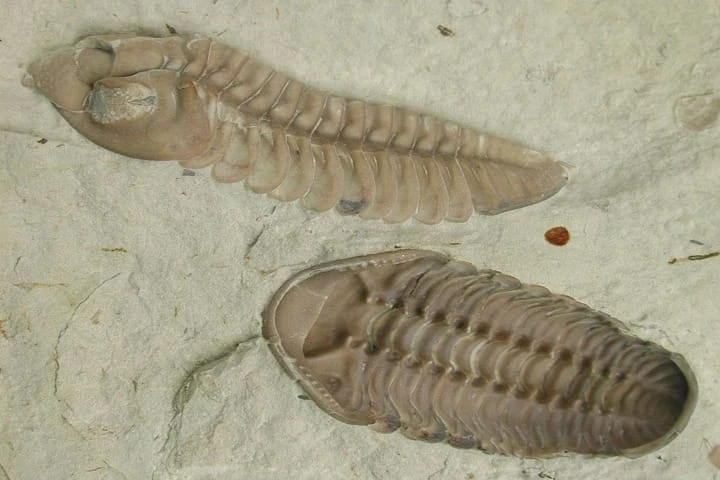

Cannibalism or eating one’s own species can be traced to ancient times – even before dinosaurs -- among trilobites of the Cambrian era (Pic. Courtesy wikimedia commons)
<p>
<strong>Though sounding abominable, cannibalism or eating one&rsquo;s own species is not limited to the present age or past but to ancient times &ndash; even before dinosaurs — among trilobites of the Cambrian era that is 541 million years ago.</strong></p>
<p>
A report in livescience.com mentions that new research brings to light that these trilobites &ndash; armoured predators &ndash; preyed on not just smaller and weaker creatures but took a bite of members of their own species.</p>
<p>
Significantly this discovery presents the evidence of earliest known cannibalism in the fossil record to date.</p>
<p>
These marine arthropods which are no more were stout creatures and had hefty exoskeletons and that is one of main reasons for the preservation of so many trilobite fossils. Exoskeletons have the ability to fossilise easily than tissues that are softer.</p>
<p>
<strong>Also read: <a href="https://www.indianarrative.com/science-news/cannibalism-in-australian-cane-toads-triggers-evolutionary-changes-112393.html">Cannibalism In Australian Cane Toads Triggers Evolutionary Changes</a></strong></p>
<p>
For the last five years, palaeontologist Russell Bicknell of Australia&rsquo;s University of New England has been studying trilobite fossils from the Emu Bay Shale formation which are located in South Australia&rsquo;s Kangaroo Island. Two trilobite species from the same genus are found in this formation. These are Redlichia takooensis, a deposit feeder which fed on the particles on the ocean floor, and R. rex, which was larger and predatory.</p>
<p>
Several of the R. takooensis fossils discovered had on their hind ends what looked like bite marks. This was per the expectation of the palaeontologists who knew that R. rex&rsquo;s diet included R. takooensis. The fossilised faeces or coprolites of R. rex found in the Emu Bay formation had in them remnants of trilobite shell. This evidence points at the ability of the R. rex to eat smaller trilobite species. While this may have been expected by the researchers but the similar bite signs on R. rex was not. These they felt were a likely to have been caused by cannibalism.</p>
<p>
Talking to Live Science, Bicknell said: <a href="https://www.livescience.com/oldest-cannibalism-found-in-trilobite-fossils?utm_source=SmartBrief&amp;utm_medium=email&amp;utm_campaign=368B3745-DDE0-4A69-A2E8-62503D85375D&amp;utm_content=D602C649-BD0D-4541-8FCD-27C83652CC08&amp;utm_term=c2029947-e980-4274-bc11-2f4c117930b6">&quot;There&#39;s not much else in this deposit</a> that has the toolkit, is biomechanically optimized for this kind of thing, and could willingly crunch down on something hard.&rdquo;</p>
<p>
The palaeontologist is sure that these were not traditional bite injuries. The trilobite&rsquo;s underside had two rows of legs, and on these there were little inward-facing spines &ndash; which were quite like the modern tool used to crack open shells. The R. rex had the innate quality to hunt trilobites irrespective of the species.</p>
<p>
The injuries on the fossils of Emu Bay are generally located on the abdomen and not the head. This as per Bicknell is due to the injured creature trying to escape from the clutches of the predator. At the same time, he also stated that injured fossils are of those creatures who escaped while those who didn&rsquo;t and ended up as coprolites may have received head injuries.</p>
<p>
Though the trilobite fossils present the earliest recorded example of cannibalism in any animal, Bicknell feels that this trait is much older and far more prevalent that what the fossils show. &ldquo;I would go as far as to say that arthropods have been eating arthropods since the dawn of arthropods becoming arthropods.&rdquo;</p>
<p>
Even though in this research, the scientists did not show that cannibalism took place, what they did was to remove all other possible explanations that could clarify these injuries that were discovered in R. rex fossils. &quot;What you&#39;re left with is this almost demonstrable record of cannibalism, just short of going back in time and watching it happen,&quot; said Bicknell.</p>
<p>
Details of this research were published in the journal Palaeogeography, Palaeoclimatology, Palaeoecology.</p>
The United Kashmir People's National Party (UKPNP) held a demonstration outside the United Nations headquarters…
President William Lai has discussed how pro-Taiwan and pro-China groups can agree to maintain solidarity…
Union Minister Jitendra Singh on Wednesday hailed Prime Minister Narendra Modi's decision to open up…
Tibetan Government-in-Exile President Sikyong Penpa Tsering concluded a significant three-day official visit to the UK…
By Amrit Prakash India unveiled its first Advanced Traffic Management System (ATMS) project at Delhi's…
The Indian Armed Forces actively participated in the ongoing multinational exercise 'Khaan Quest 2025' at…